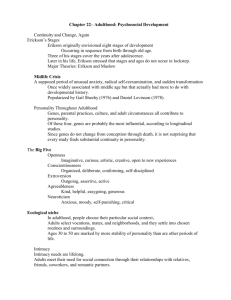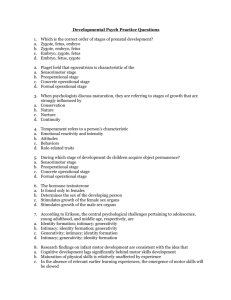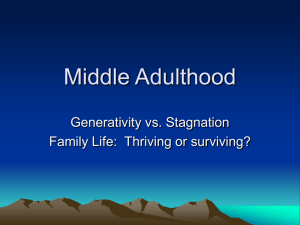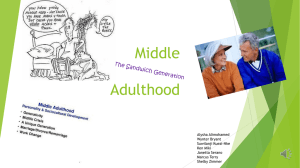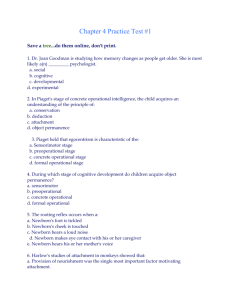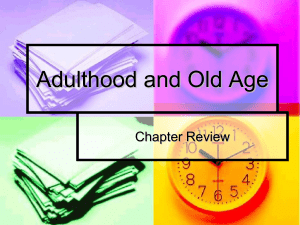adult life development tasks
advertisement
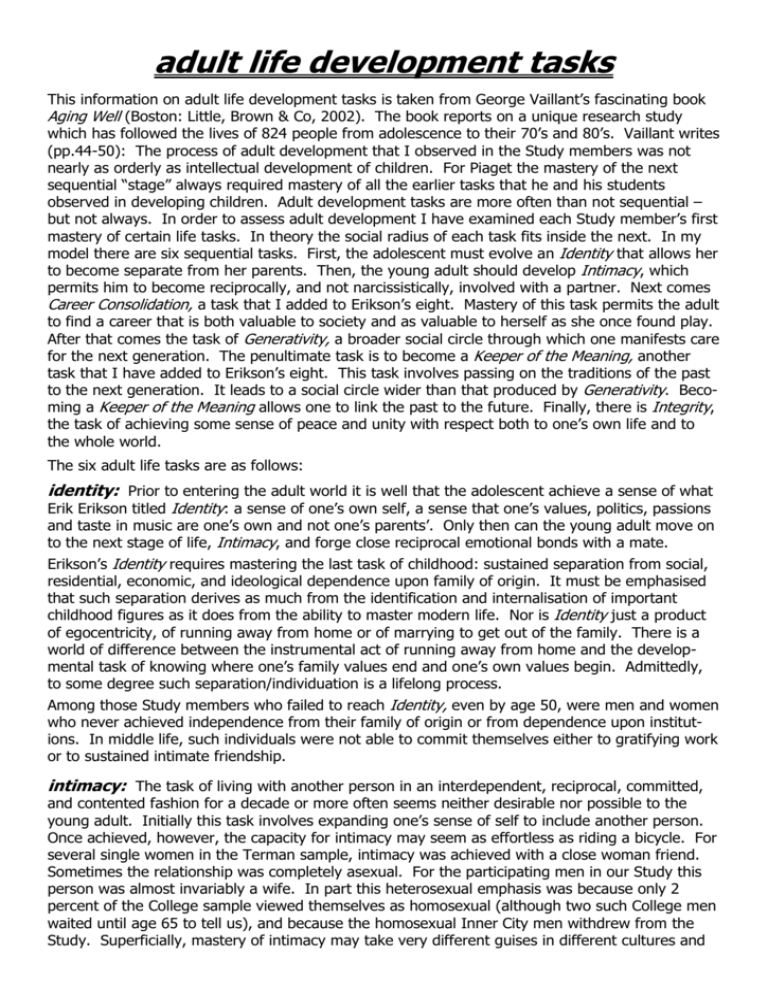
adult life development tasks This information on adult life development tasks is taken from George Vaillant’s fascinating book Aging Well (Boston: Little, Brown & Co, 2002). The book reports on a unique research study which has followed the lives of 824 people from adolescence to their 70’s and 80’s. Vaillant writes (pp.44-50): The process of adult development that I observed in the Study members was not nearly as orderly as intellectual development of children. For Piaget the mastery of the next sequential “stage” always required mastery of all the earlier tasks that he and his students observed in developing children. Adult development tasks are more often than not sequential – but not always. In order to assess adult development I have examined each Study member’s first mastery of certain life tasks. In theory the social radius of each task fits inside the next. In my model there are six sequential tasks. First, the adolescent must evolve an Identity that allows her to become separate from her parents. Then, the young adult should develop Intimacy, which permits him to become reciprocally, and not narcissistically, involved with a partner. Next comes Career Consolidation, a task that I added to Erikson’s eight. Mastery of this task permits the adult to find a career that is both valuable to society and as valuable to herself as she once found play. After that comes the task of Generativity, a broader social circle through which one manifests care for the next generation. The penultimate task is to become a Keeper of the Meaning, another task that I have added to Erikson’s eight. This task involves passing on the traditions of the past to the next generation. It leads to a social circle wider than that produced by Generativity. Becoming a Keeper of the Meaning allows one to link the past to the future. Finally, there is Integrity, the task of achieving some sense of peace and unity with respect both to one’s own life and to the whole world. The six adult life tasks are as follows: identity: Prior to entering the adult world it is well that the adolescent achieve a sense of what Erik Erikson titled Identity: a sense of one’s own self, a sense that one’s values, politics, passions and taste in music are one’s own and not one’s parents’. Only then can the young adult move on to the next stage of life, Intimacy, and forge close reciprocal emotional bonds with a mate. Erikson’s Identity requires mastering the last task of childhood: sustained separation from social, residential, economic, and ideological dependence upon family of origin. It must be emphasised that such separation derives as much from the identification and internalisation of important childhood figures as it does from the ability to master modern life. Nor is Identity just a product of egocentricity, of running away from home or of marrying to get out of the family. There is a world of difference between the instrumental act of running away from home and the developmental task of knowing where one’s family values end and one’s own values begin. Admittedly, to some degree such separation/individuation is a lifelong process. Among those Study members who failed to reach Identity, even by age 50, were men and women who never achieved independence from their family of origin or from dependence upon institutions. In middle life, such individuals were not able to commit themselves either to gratifying work or to sustained intimate friendship. intimacy: The task of living with another person in an interdependent, reciprocal, committed, and contented fashion for a decade or more often seems neither desirable nor possible to the young adult. Initially this task involves expanding one’s sense of self to include another person. Once achieved, however, the capacity for intimacy may seem as effortless as riding a bicycle. For several single women in the Terman sample, intimacy was achieved with a close woman friend. Sometimes the relationship was completely asexual. For the participating men in our Study this person was almost invariably a wife. In part this heterosexual emphasis was because only 2 percent of the College sample viewed themselves as homosexual (although two such College men waited until age 65 to tell us), and because the homosexual Inner City men withdrew from the Study. Superficially, mastery of intimacy may take very different guises in different cultures and epochs, but “mating-for-life” and “marriage-type love” is built into the wiring of many warmblooded species. career consolidation: Mastery of this task involves expanding one’s personal identity to assume a social identity within the world of work. On a desert island one can have a hobby, but not a career; for careers involve other people. Individuals with severe personality disorder often manifest a lifelong inability to work. In his own work Erikson discussed Career Consolidation only obliquely and sometimes did not distinguish self-identity from career identity. But I believe that there are four crucial developmental criteria that transform a “job” or hobby into a “career”: contentment, compensation, competence, and commitment. Obviously, such a career can be “wife and mother” – or in more recent times, “husband and father”. To the outsider the process of Career Consolidation often appears “selfish”, but without such a “selfishness” one becomes “selfless” and has no “self” to give away. Henrik Ibsen in his play A Doll’s House depicts Nora’s “selfish” escape from her husband. Her husband, who in the pejorative sense really is selfish, demands that Nora care only for him and the children. Since Career Consolidation never justifies the abandonment of children, Nora’s leaving her family behind is a metaphor, not a recipe for living to be literally copied. Nevertheless, unless Nora slams the doll house door and develops her own satisfying career, she can never hope to become a generative mentor to her daughter’s generation. generativity: Mastery of the fourth task, Generativity, involves the demonstration of a clear capacity to unselfishly guide the next generation. Generativity reflects the capacity to give the self – finally completed through mastery of the first three tasks of adult development – away. Just as Intimacy reflects a capacity for mutual interdependence; just so Generativity reflects a different sort of capacity – to be in relationships where one “cares” for those younger than oneself and, simultaneously, respects the autonomy of others. Generativity (and leadership) means to be in a relationship in which one gives up much of the control that parents retain over younger children and learn to hold loosely. Generativity means community building. Depending on the opportunities that the society makes available, Generativity can mean serving as a consultant, guide, mentor, or coach to young adults in the larger society. Research reveals that between age 30 and 45 our need for achievement declines and our need for community and affiliation increases. We may view deans, matriarchs, and business magnates as the products of crass ambition and infantile narcissism. But in so doing we ignore the psychosocial skills necessary to allow one individual to assume sensitive responsibility for other adults. Empathic leadership only looks like self-aggrandizement until one tries to do it. In all three Study cohorts, mastery of Generativity tripled the chances that the decade of the 70’s would be for these men and women a time of joy and not of despair. keeper of the meaning: Mastery of this fifth task is epitomized by the role of the wise judge. Again, Erikson obliquely refers to the importance of this task, but in his writing he assigned parts of the task to Generativity and parts to Integrity. Generativity and its virtue, care, require taking care of one person rather than another. The role of Keeper of the Meaning and its virtues of wisdom and justice is less selective. Justice, unlike care, means not taking sides. The focus of a Keeper of the Meaning is on conservation and preservation of the collective products of mankind – the culture in which one lives and its institutions – rather than on just the development of its children. Some people call such dispassionate approach to life by the elderly stodgy, but that is to miss the point. As Erik Erikson suggests, there are dialectical tensions to every development task – Intimacy versus Isolation, Generativity versus Stagnation. And so with Keeper of the Meaning, the danger is rigidity. Put differently, to preserve one’s culture involves developing concern for a social radius that extends beyond one’s immediate community. This is not a trivial distinction. We can all appreciate the difference in social maturation between the partisan and successfully generative Ronald Reagan who called the other side “the Evil Empire” and a wise leader like Abraham Lincoln, who did his utmost to heal and to forgive the wounds of civil war. The generative individual cares for an individual in a direct, future-orientated relationship – as, for example, a mentor or teacher. In contrast, the Keeper of the Meaning speaks for past cultural achievements and guides groups, organisations, and bodies of people toward the preservation of past traditions. The organisers, judges, and guardians of the Olympic Games play a very different role from the Games’ more generative coaches. In addition, the former have a lot more grey hair. Matriarchs, genealogy mavens, and antiques refinishers are all exemplars of what is involved in becoming a Keeper of the Meaning. Clearly such caretakers are not superior to caregivers. The distinction is only that a seventy-year-old is usually better at being a Keeper of the Meaning than a thirty-year-old. To expand on Erikson’s concept of a “widening social radius”, let me invoke the simple and cul turally universal example of grandparents. Who has not known at least one seventy-year-old woman who was able to be closer, wiser, more empathic toward her grandchildren than she ever had been in the prime of life toward her own children? Grandfathers may need canes and false teeth and grandmothers need bifocals and hearing aids. But they, and they alone, elicit a special trust from grandchildren and teach them meaningfully about the past. integrity: This is the last of life’s great tasks. Erikson described Integrity as “an experience which conveys some world order and spiritual sense. No matter how dearly paid for, it is the acceptance of one’s one and only life cycle as something that had to be and that, by necessity, permitted of no substitutions.” If care was to be the virtue of Generativity, Erik Erikson suggested that wisdom was the virtue of Integrity. “As for the final strength, wisdom, we have formulated it thus: wisdom is detached concern with life itself, in the face of death itself. It maintains and learns to convey an integrity of experience in spite of the decline of bodily and mental function.” Admittedly, some individuals, often due to great stress, tackle developmental tasks out of order or all at once. Alexander the Great, General Lafayette, Napoleon Bonaparte, and Joan of Arc were inspirational and generative leaders in their twenties. William Osler, one of the greatest physicians of all time, did not confront the task of Intimacy until he married at age 40 – well after he had established his career as a brilliant professor of medicine and as the most generative physician of his era. Ludwig van Beethoven enjoyed a brilliant committed career, but never enjoyed Intimacy. Adult development does not follow rigid rules. Nevertheless, the usually sequential mastery of these tasks through Keeper of the Meaning has been documented for both the Terman and the Harvard samples and for the Inner City sample through Generativity. Of course, there are many differences between women and men; but with the passage of decades both genders appear to follow Erikson’s sequence of expanding social radii. In a recent review of three longitudinal studies of women’s development – from the University of Michigan, from Mills College, and from Smith College – between ages 30 and 60 women increased both in Generativity and in confidence in their power and authority. Indeed, the authors found evidence that some aspects of women’s well-being (positive relations with others, personal growth) are somewhat better than men’s at all ages, and none are worse. Once again careful longitudinal study gives the lie to William James’s – and Sigmund Freud’s – pessimism about adult development. I must close, however, with a caveat. One life stage is not better or more virtuous than another. Adult development is neither a footrace nor a moral imperative. It is a road map to help us make sense of where we and where our neighbours might be located. It also contributes to our “wholeness” from which our word “health” is derived. In old age there are many losses & these may overwhelm us if we have not continued to grow beyond ourselves.
